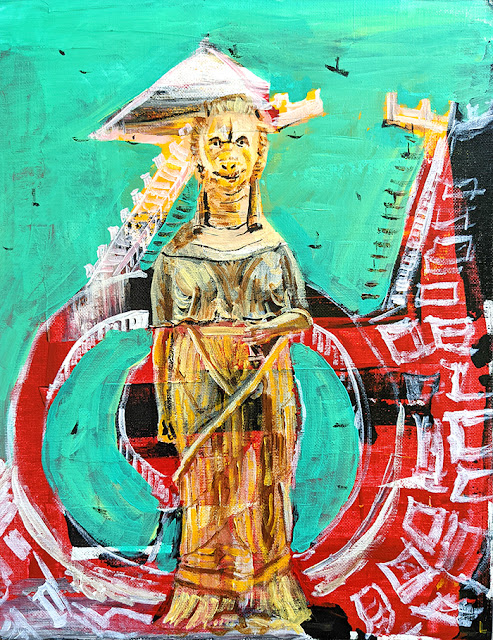Tanit was the Great Goddess of Carthage. She was the chief deity of the wealthy African port city, located on the Mediterranean coast of what is now Tunisia. Tanit was a heavenly goddess of war, a "virginal" (unmarried) mother goddess and nurse, and, less specifically, a symbol of fertility. She is considered to be an avatar of Astarte/Asherah/Ishtar/Inanna/Anat, and was adopted by the Romans as Juno Caelestis. She may also be personified by legendary Etruscan queen Tanaquilo. Additionally, like Astarte, Tanit is a Goddess of the sea and sailors.
Tanit is sometimes portrayed with the head of a lion, wearing a garment made of feathers. This fits with an identity related to the Great Mother Goddesses of the ancient Mediterranenan. Astarte, Asherah, Ishtar, and Inanna are all associated with lion imagery. The Burney Relief famously shows Ishtar or another Great Mother avatar with wings and feet reminiscent of a bird of prey. Anat is also associated with birds of prey. Marija Gimbutas theorizes that the association of the Goddess with birds of prey is related to the role of the Goddess in rebirth, following the process of exhumation wherein birds of prey strip the bones clean.
"Her temple in Carthage was called the Shrine of the Heavenly Virgin. Greek and Roman writers called it a temple of the moon. Another of her titles was Astroarche, Queen of the Stars. Her priestesses were famous astrologers, whose prophecies were circulated throughout the Roman Empire.
"Though Romans destroyed Carthage in the Punic Wars, Roman legend traced the very origin of Rome to the Carthaginian mother-city, as shown by the story of Aeneas, who came directly across the Mediterranean from there, to found Rome. The primitive Roman queen Tanaquil, who conferred sovereignty on the "fatherless" Latin kings, the Tarquins, was none other than the Libyan Goddess Tanit. She was also known as Libera, Goddess of Libya, whose festival the Liberalia was celebrated each year in Rome during the Ides of March.
"The distinctive symbol of Tanit was a pyramidal shape, like a woman in a very full skirt, topped by a disc-shaped full-moon head, with upraised arms in the manner of the Egyptian ka. Similar symbols represented such goddesses as Aphrodite, Athene, Venus, and Juno.
Tanit was worshipped throughout the Western Mediterranean, in Sicily, Malta, North Africa, Gades and many other places into Hellenistic times, possibly extending as far as Britain - the eminent linguist Dr Theo Vennemann believes that the Isle of Thanet, Easternmost promontory of Kent, was named for her. Source 1, Source 2
Tanit still receives prayers today. According to Wikipedia, "In modern-day Tunisian Arabic, it is customary to invoke Omek Tannou or Oumouk Tangou ('Mother Tannou' or 'Mother Tangou', depending on the region), in years of drought to bring rain."
On the island of Ibiza,
Local tradition dictated that all the most valuable land was passed down to the male children. At the time, this meant that the boys got all the best farmland, located generally in the middle of the island. The coastal lands, considered to be useless for growing crops and thus of very little value would be passed to the females.
"Word has it that a whole bunch of island women got together, one historic full-moon, to dance for Tanit and ask for her assistance with what they saw as the unfair distribution of family wealth that effectively forced them into either poverty or marriage.
"It wasn't long afterwards that the hippies began to arrive, tourism followed quickly afterwards and hey presto, there was a real estate boom and guess what? Suddenly coastal lands belonging to the females were the most sought after and leapt in value. Whereas the agricultural land in the centre of island owned by the males dropped in value as the economy shifted to focus onto tourism. Another coincidence?
Finally, Tanit also is the source of the earliest usage of the Hamsa symbol, in Carthage between 1550 and 330 BCE. The hamsa is a palm-shaped amulet popular throughout the Maghreb and in the Middle East. Depicting the open right hand, an image recognized and used as a sign of protection in many times throughout history, the hamsa is believed by middle easterners, to provide defense against the evil eye. The hamsa holds recognition as a bearer of good fortune among Christians in the Middle East as well.
"The Phoenicians used an image of the hand to represent Tanit, patron goddess of their capital city Carthage and controller of the lunar cycle. With time, her hand became a protective amulet in its own right and was used to ward off the evil eye, one of the oldest manifestations of human fear. The symbol was adopted by the ancient Sephardic Jewish community of the Iberian Peninsula, who named it the Hand of Miriam after the sister of the biblical Moses and Aaron and associated it with the number five (hamesh in Hebrew) to represent the five books of the Torah. It also symbolizes the fifth letter of the Hebrew alphabet, "Het", which represents one of God's holy names, and further reminds Jews to use their five senses when praising God.
"The hand, the eye, and the number five figure significantly in Arabic and Berber tradition and also relate to warding off the evil eye. Here, the Hamsa is called the Hand of Fatima after Fatima Zahra, daughter of the Prophet Muhammad. The five fingers of the hand are further associated with the Five Pillars of Islam. While Qu'ran law prohibits the wearing of charms and amulets, the Hamsa symbol is often depicted in and associated with Islamic cultures. Source.









Comments
Post a Comment